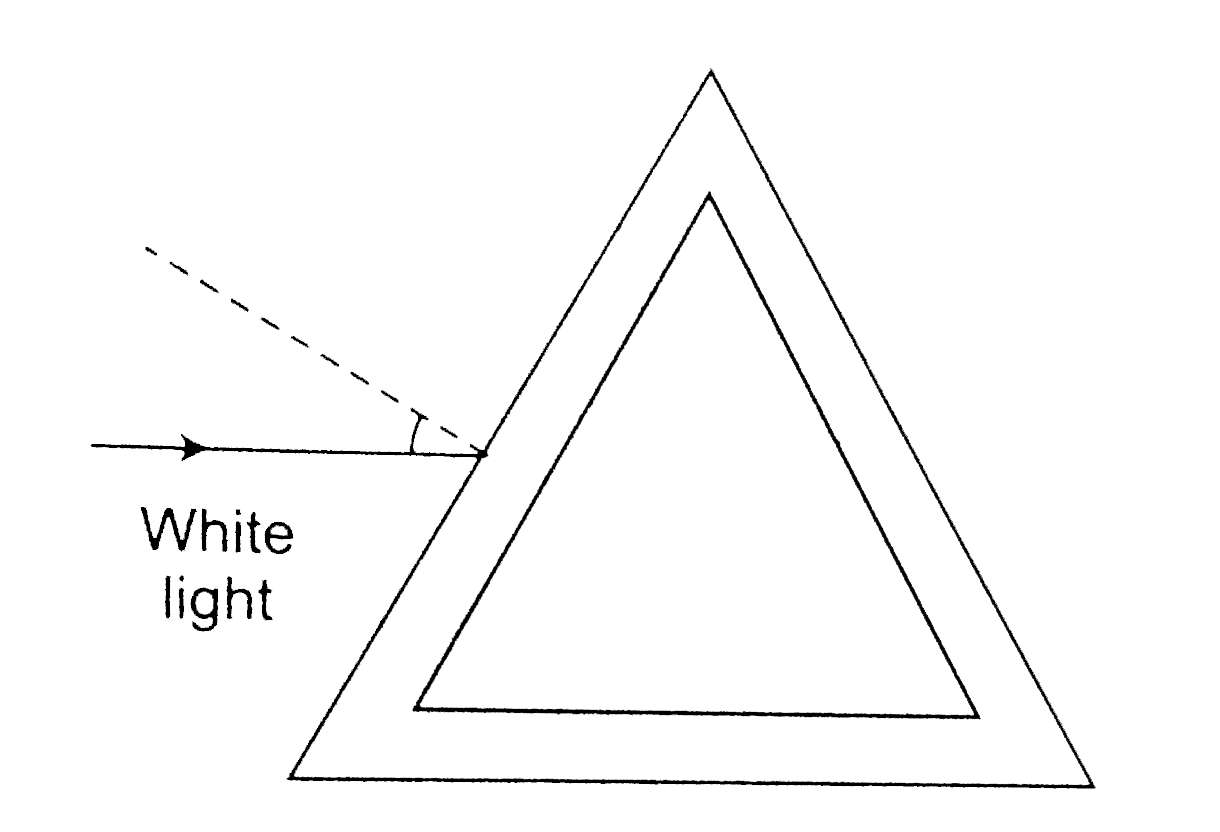In an experiment, Pooja used a equilateral triangular glass prism and projected a narrow beam of white light source from one side of the surface of the prism. She placed a screen on the other side and saw many colours appearing as patches on the screen. But when she used a red light source, she could only see a red patch on the screen. Similarly she used a blue and green light source and could only see one colour patch on both occasions.
Which of the following can be the correct explanation that Pooja can give to her friends to explain this phenomenon?
Different lights travel faster in the glass prism at different rates.
Any light would disperse in the prism.
Enough data is not available to make a scientific explanation in this case.
Different wavelengths travel at different speeds in the glass.
Step by step video & image solution for In an experiment, Pooja used a equilateral triangular glass prism and projected a narrow beam of white light source from one side of the surface of the prism. She placed a screen on the other side and saw many colours appearing as patches on the screen. But when she used a red light source, she could only see a red patch on the screen. Similarly she used a blue and green light source and could only see one colour patch on both occasions. Which of the following can be the correct explanation that Pooja can give to her friends to explain this phenomenon? by Physics experts to help you in doubts & scoring excellent marks in Class 10 exams.
Updated on:21/07/2023Topper's Solved these Questions
- SAMPLE PAPER 2022BOOK - CBSE MODEL PAPERCHAPTER - SAMPLE PAPER 2022EXERCISE - ALTERNATIVE QUESTIONS(SECTION B)
3 Videos
- SAMPLE PAPER (MATHEMATICS STANDARD)BOOK - CBSE MODEL PAPERCHAPTER - SAMPLE PAPER (MATHEMATICS STANDARD)EXERCISE - PART - B
16 Videos
- SAMPLE PAPER 2022 TERM IIBOOK - CBSE MODEL PAPERCHAPTER - SAMPLE PAPER 2022 TERM IIEXERCISE - SECTION C
2 Videos
Similar Questions
In an experiment, Pooja used a equilateral triangular glass prism and projected a narrow beam of white light source from one side of the surface of the prism. She placed a screen on the other side and saw many colours appearing as patches on the screen. But when she used a red light source, she could only see a red patch on the screen. Similarly she used a blue and green light source and could only see one colour patch on both occasions.
The phenomenon that she was trying to demonstrate was:
View SolutionIn an experiment, Pooja used a equilateral triangular glass prism and projected a narrow beam of white light source from one side of the surface of the prism. She placed a screen on the other side and saw many colours appearing as patches on the screen. But when she used a red light source, she could only see a red patch on the screen. Similarly she used a blue and green light source and could only see one colour patch on both occasions.
The reason why she could no see any other colour when the red light was used was because:
View Solution
Knowledge Check
A beam of white light is incident on a hollow prism of glass. Then
 Athe light emerging from prism gives spectrum but the bending of all colours is always from baseBthe light emerging from prism gives spectrum, all the colours bend towards the base, the violet must and red and leastCthe light emerging from prism gives spectrum, all the colours bend towards base, the red the least and violet the mostDthe light emerging from prism gives no spectrum
Athe light emerging from prism gives spectrum but the bending of all colours is always from baseBthe light emerging from prism gives spectrum, all the colours bend towards the base, the violet must and red and leastCthe light emerging from prism gives spectrum, all the colours bend towards base, the red the least and violet the mostDthe light emerging from prism gives no spectrumA beam of white light is shone onto a glass prism. The light cannot be :
ADeviatedBDispersedCFocusedDRefracted
In an experiment, Pooja used a equilateral triangular glass prism and projected a narrow beam of white light source from one side of the surface of the prism. She placed a screen on the other side and saw many colours appearing as patches on the screen. But when she used a red light source, she could only see a red patch on the screen. Similarly she used a blue and green light source and could only see one colour patch on both occasions.
She also could relate to another natural phenomenon that we observe on a rainy humid day as the sun comes out. What could be that phenomenon?
View SolutionHow will you use two identical prisms so that a narrow beam of white light incident on one prism emerges out of the second prism as white light?
View SolutionHow will you use two identical glass prisms so that a narrow beam of white light incident on one prism emerges out of the second prism as white light? draw and label the ray diagram
View SolutionHow will use two identical glass prisms so that a narrow beam of white light incident on one prism emerges out of the second prism as white light ? Draw and label the ray diagram.
View SolutionHow will you use two identical prisms so that a narrow beam of white light incident on one prism emerges out of the second prism ay white light? Draw the diagram.
View SolutionHow will you use two indentical prisms so that a narrow beam of white light incident on one prism emerges out of the second prism as white light ? Draw the diagram.
View Solution
